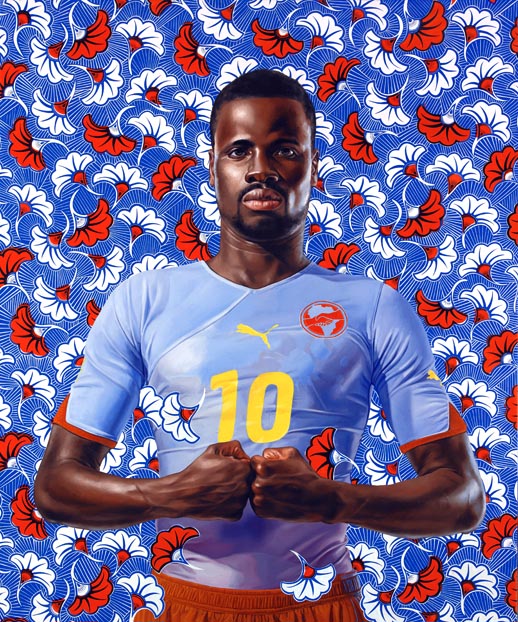Kehinde Wiley Paints the World Stage

KEHINDE WILEY, EMMANUEL EBOUE, 2010.
COURTESY THE ARTIST
Kehinde Wiley’s homoerotic portraiture generally romanticizes the unknown: street-cast African American kids honorably putting in their time as a menacing other. But for a PUMA commission celebrating the 2010 FIFA World Cup in South Africa, Wiley depicts athletes at the height of visibility (and homophilia): soccer stars Samuel Eto’o of Cameroon, John Mensah of Ghana and Emmanuel Eboué of Ivory Coast.
Legends of Unity—a series featuring group and individual portraits of the three players, and a documentary—stopped at Deitch Projects’ Wooster Street space last weekend. The New York showing is part of a multi-country tour of the exhibition, which kicked off in Berlin earlier this month and will end in South Africa in June.
“So much of what I wanted to do with this project was get away from the televisual notions of disease, war, famine that we are sort of constantly bombarded with in regards to looking at Africa,” said Wiley in an interview Friday afternoon at Deitch. “And here is a chance to provide not just some sort of cheesy political correcting, but rather something that is, I think, more indicative of a type of honest engagement with the process of what I had been doing for years in America and having that transposed to Africa.”
Wiley traveled to each player’s home country last June, where he and the athletes sat down over art books of pre-colonial West African sculpture, choosing a Nigerian piece featuring a king flanked by supporters as the basis for the group portrait and sculptures from each player’s country of origin for the other paintings. “I’ve always allowed the models to have a really strong hand in the way the paintings were constructed… from working on the streets of Brooklyn to the streets of Harlem, really going through Western European historical objects and seeing the models’ responses,” Wiley said.
The portraits’ backdrops are inspired by African textiles. Wiley paints the soccer players in bright swathes of poppies, golden keys and snake-like vegetation. Resonance with Africa’s decorative history is something Wiley first sought two years ago, while working on The World Stage: Africa, Lagos—Dakar World Stage at Harlem’s Studio Museum. At that point he began experimenting with African patterns in fashion. The new PUMA Africa apparel collection, which is also touring with Legends of Unity, uses patterns from the artist’s earlier work.
Although Wiley is most often associated with his injection of black American hip-hop culture into Old Masters-style portraiture, he emphasizes that his work now is more about the international “echo effect” of an urban sensibility. For a recent exhibition in Rio de Janeiro, the models Wiley found in favelas, “in regards to dress code and attitude, may be more congruent to this notion of American hip hop culture than anything else,” he said. “The question then becomes what unique aspects of each of these paintings or each of these individuals give rise to a notion of national identity or global color.” Upcoming projects will see Wiley looking for other echoes: The artist will follow the paths of Ethiopian Jews in Israel and streetcast in Kabul for a painting of the Bamiyan Buddhas.
KEHINDE WILEY: LEGENDS OF UNITY MOVES TO LONDON, ELMS LESTERS, FEBURARY 22. THE SHOW MOVES TO TOKYO, MARCH 3–4; BEIJING, MARCH 9–24; MILAN, APRIL 13–14.






